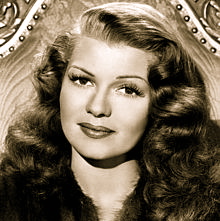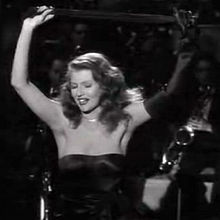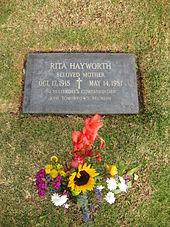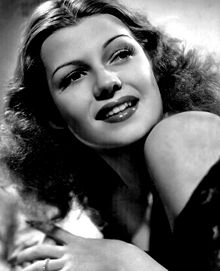Rita Hayworth

Rita Hayworth

1945
Rita Hayworth (born Margarita Carmen Cansino; October 17, 1918 – May 14, 1987) was an American dancer and film actress who garnered fame during the 1940s as one of the era’s top stars. Appearing first as Rita Cansino, she agreed to change her name to Rita Hayworth and her hair color to dark red to attract a greater range of roles. Her appeal led to her being featured on the cover of Life magazine five times, beginning in 1940.
The first dancer featured on film as a partner of both the stars Fred Astaire and Gene Kelly, Hayworth appeared in a total of 61 films over 37 years. She is listed by the American Film Institute as one of the 100 Greatest Stars of All Time.
Life and work – Early life
Hayworth was born in Brooklyn, New York in 1918 as Margarita Carmen Cansino, the oldest child of two dancers, Eduardo Cansino, Sr., from Castilleja de la Cuesta, a little town near Seville, Spain, and Volga Hayworth, an American of Irish-English descent who had performed with the Ziegfeld Follies. The Catholic couple had married in 1917. They also had two sons: Eduardo, Jr. and Vernon.
Margarita’s father wanted her to become a professional dancer, while her mother hoped she would become an actress. Her paternal grandfather Antonio Cansino was renowned as a Spanish classical dancer; he popularized the bolero and his dancing school in Madrid was world famous. Rita later recalled, “From the time I was three and a half… as soon as I could stand on my own feet, I was given dance lessons.” She noted “I didn’t like it very much… but I didn’t have the courage to tell my father, so I began taking the lessons. Rehearse, rehearse, rehearse, that was my girlhood.” She attended dance classes every day for a few years in a Carnegie Hall complex, where she was taught by her uncle Angel Cansino. She performed publicly from the age of six. In 1926 at the age of eight, she was featured in La Fiesta, a short film for Warner Bros.
In 1927, her father took the family to Hollywood. He believed that dancing could be featured in the movies and that his family could be part of it. He established his own dance studio, where he taught such Hollywood luminaries as James Cagney and Jean Harlow. During the Great Depression, he lost all his investments, as musicals were no longer in vogue and commercial interest in his dancing classes waned. He partnered with his daughter to form “The Dancing Cansinos”. Since under California law, Margarita was too young to work in nightclubs and bars, her father took her with him to work across the border in Tijuana, Mexico. In the early 1930s, it was a popular tourist spot for people from Los Angeles. Due to her working, Cansino never graduated from high school; she completed ninth grade at Hamilton High in Los Angeles.
At the age of 16, Cansino took a bit part in the film Cruz Diablo (1934), which led to another in In Caliente (1935) with the Mexican actress Dolores del Río. Cansino danced with her father in such nightspots as the Foreign and the Caliente clubs. Winfield Sheehan, the head of the Fox Film Corporation, saw her dancing at the Caliente Club and quickly arranged for Hayworth to do a screen test a week later. Impressed by her screen persona, Sheehan signed her for a short-term six-month contract at Fox, under the name Rita Cansino, the first of name changes for her film career.
Early career
During her time at Fox, Cansino appeared in five pictures, in non-notable roles. By the end of her six-month contract, Fox had merged into 20th Century Fox, with Darryl F. Zanuck serving as the executive producer. Dismissing Sheehan’s interest in Cansino, Zanuck did not renew her contract. Feeling that Cansino had screen potential, the salesman and promoter Edward C. Judson, whom she would marry in 1936, got her the lead roles in several independent films and arranged a screen test with Columbia Pictures. The studio head Harry Cohn signed Cansino to a long-term contract, and cast her in small roles in Columbia features.
Often cast as the exotic foreigner, Cansino appeared in several roles in 1935: in Dante’s Inferno, with Spencer Tracy; and Paddy O’Day, in which she played a Russian dancer. She was an Argentinian in Under the Pampas Moon and an Egyptian beauty in Charlie Chan in Egypt. In 1936 she took her first starring role as a “Latin type” in Human Cargo.
Cohn argued that Cansino’s image was too Mediterranean, which reduced her opportunities to being cast in “exotic” roles, more limited in number. With Cohn and Judson’s encouragement, Hayworth changed her hair color to dark red and her name to Rita Hayworth. She had electrolysis to raise her hairline and broaden the appearance of her forehead. By using her mother’s maiden name, she led people to see her British-American ancestry and became a classic “American” pin-up.
In 1937, Hayworth appeared in five minor Columbia pictures and three minor independent movies. The following year, she appeared in five Columbia B films. In 1939, Cohn pressured director Howard Hawks to use Hayworth for a small but important role as a man-trap in the aviation drama Only Angels Have Wings, in which she played opposite Cary Grant and Jean Arthur. With this film’s box-office success, fan mail for Hayworth began pouring into Columbia’s publicity department. Cohn began to see Hayworth as his first and official new star. The studio never officially had stars under contract, except for Jean Arthur, who was trying to break with it.
 with Fred Astaire in You Were Never Lovelier (1942)
with Fred Astaire in You Were Never Lovelier (1942)
Cohn began to build Hayworth up in 1940, in features such as Music in My Heart, The Lady in Question, and Angels Over Broadway. That year she was first featured in a Life magazine photo. He loaned Hayworth to Metro-Goldwyn-Mayer to appear in Susan and God, opposite Joan Crawford. While on loan to Warner Brothers, Hayworth appeared as the second female lead in The Strawberry Blonde (1941), opposite James Cagneyand Olivia de Havilland. As the film was a big box-office success, Hayworth’s popularity rose; she immediately became one of Hollywood’s hottest properties. So impressed was Warner Brothers that they tried to buy Hayworth’s contract from Columbia, but Cohn refused to release her.
Her success led to a supporting role in Blood and Sand (1941), opposite Tyrone Power and Linda Darnell, with Fox, the studio that had dropped her six years before. In one of her most notable screen roles, Hayworth played Doña Sol des Muire, the first of many screen sirens. This was another box-office hit.
She returned in triumph to Columbia Pictures and was cast in the musical You’ll Never Get Rich (1941) opposite Fred Astaire, in one of the highest-budgeted films Columbia had ever made. So successful was the picture that the following year, the studio produced and released another Astaire-Hayworth picture, You Were Never Lovelier. In 1942, Hayworth also appeared in two other pictures, Tales of Manhattan and My Gal Sal.
During this period, Hayworth was featured in an August 1941 Life Magazine photo, in which she lounged seductively in a black-lace negligee. When the U.S. joined World War II in December 1941, the photo made Hayworth one of the top two “pin-up girls” of the war years; the other was the blonde Betty Grable. In 2002, the satin nightgown Hayworth wore for the photo sold for $26,888.
Peak years at Columbia
In 1944, Hayworth made one of her best-known films, the Technicolor musical Cover Girl (1944), with Gene Kelly. The film established her as Columbia’s top star of the 1940s. For three consecutive years, starting in 1944, Hayworth was named one of the top movie box office attractions in the world. She was adept in ballet, tap, ballroom, and Spanish routines.
Cohn continued to showcase Hayworth’s dance talents; she was the first dancer featured on film to partner with both Fred Astaireand Gene Kelly. Columbia featured her in the Technicolor films: Tonight and Every Night (1945), with Lee Bowman; and Down to Earth (1947), with Larry Parks.
 Hayworth in the strip scene from Gilda(1946).
Hayworth in the strip scene from Gilda(1946).
Her erotic appeal was most noted in Charles Vidor‘s black and white film noir Gilda(1946), with Glenn Ford, which caused censors some consternation. The role, in which Hayworth in black satin performed a legendary one-glove striptease, made her into a cultural icon as a femme fatale. While her film was still in release, extensive publicity linked her to a widely covered nuclear bomb test in the South Pacific.
Numerous reporters from hundreds of papers across the country were covering preparations in 1946 at Bikini Atoll in the Pacific Ocean’s Marshall Islands for testing of the first nuclear bomb after World War II. The United States had been the first nation to use nuclear bombs, against the civilian population of Japan. Reporters publicized that young scientists had put the name of “Gilda” and Hayworth’s image on the bomb, alluding to her bombshell status as a film star. Coverage varied widely at the time, but the story stuck that her image had been put on the bomb, and was repeated in her 1987 obituary in The New York Times, which readers relied on as fact. Her husband Orson Welles issued a public statement at the time, saying they would be pleased only if this were the last bomb test ever. Hayworth was furious to be used in this way.
Her biographer Barbara Leaming had a later interview with Welles in which he recalled,
“… the angriest was when she found out that they’d put her on the atom bomb. Rita almost went insane, she was so angry. She was so shocked by it! Rita was the kind of person that kind of thing would hurt more than anybody. She wanted to go to Washington to hold a press conference, but Harry Cohn (president of Columbia Pictures) wouldn’t let her because it would be unpatriotic.”
Recent research documents that only the name “Gilda” was put on the bomb; no image of Hayworth was used.
 From the trailer for Lady from Shanghai (1947)
From the trailer for Lady from Shanghai (1947)
A year later, Hayworth’s performance in The Lady from Shanghai (1947), directed by her husband Orson Welles, was critically acclaimed. The film’s failure at the box office was attributed in part to Welles’ having had Hayworth’s famous red hair cut short and dyed platinum blonde for the role. Cohn had not been consulted and was furious that Hayworth’s image was changed.
Also in 1947, Hayworth was featured in a Life cover story by Winthrop Sargeant, which led to her nickname as “The “Love Goddess.” This term was adopted and used later as the title of a biopic and of a biography about her. In a 1980s interview, Hayworth said, “Everybody else does nude scenes, but I don’t. I never made nude movies. I didn’t have to do that. I danced. I was provocative, I guess, in some things. But I was not completely exposed.”
Her next film, The Loves of Carmen (1948), again with Glenn Ford, was the first film co-produced by Columbia and Hayworth’s own production company, The Beckworth Corporation (named for her and Orson’s daughter Rebecca); it was Columbia’s biggest moneymaker for that year. She received a percentage of the profits from this and all her subsequent films until 1954, when she dissolved Beckworth to pay off debts she owed.
Health problems
Hayworth struggled with alcohol throughout her life. Her daughter Yasmin Aga Khan said,
“I remember as a child that she had a drinking problem. She had difficulty coping with the ups and downs of the business … As a child, I thought, ‘She has a drinking problem and she’s an alcoholic.’ That was very clear and I thought, ‘Well, there’s not much I can do. I can just, sort of, stand by and watch.’ It’s very difficult, seeing your mother, going through her emotional problems and drinking and then behaving in that manner … Her condition became quite bad. It worsened and she did have an alcoholic breakdown and landed in the hospital.”
In 1972, Hayworth was 54 years old and wanted to retire from acting, but she needed money so signed up for The Wrath of God. The experience exposed her poor health and worsening mental state. As she could not remember lines, they filmed her scenes one line at a time.
The following year Hayworth agreed to do one more movie, Tales That Witness Madness (1973). Due to worse health, she abandoned the movie set, and returned to the United States. She never returned to acting.
In March 1974, both her brothers died within a week of each other, which caused her great sadness and led to heavy drinking. In 1976 at London’s Heathrow Airport, Hayworth was removed from a TWA flight after having an angry outburst while traveling with her agent. “Miss Hayworth had been drinking when she boarded the plane,” revealed a TWA flight attendant, “and had several free drinks during the flight.” The event attracted much negative publicity; a disturbing photograph was published in newspapers.
Hayworth’s alcoholism hid symptoms of what was eventually understood to be Alzheimer’s disease. “For several years in the 1970s, she had been misdiagnosed as an alcoholic.” “It was the outbursts,” said her daughter, “She’d fly into a rage. I can’t tell you. I thought it was alcoholism-alcoholic dementia. We all thought that. The papers picked that up, of course. You can’t imagine the relief just in getting a diagnosis. We had a name at last, Alzheimer’s! Of course, that didn’t really come until the last seven or eight years. She wasn’t diagnosed as having Alzheimer’s until 1980. There were two decades of hell before that.”
In July 1981, Hayworth’s health had deteriorated to the point where a judge in Los Angeles Superior Court ruled that she should be placed under the care of her daughter, Princess Yasmin Khan of New York City. Hayworth lived in an apartment at The San Remo on Central Park West next to her daughter, who arranged for care for her mother through her final years.
Death
 Hayworth’s grave at Holy Cross Cemetery, Culver City, California
Hayworth’s grave at Holy Cross Cemetery, Culver City, California
Rita Hayworth lapsed into a semicoma in February 1987. She died at age 68 from Alzheimer’s disease a few months later on May 14, 1987. A funeral service was held on May 19, 1987, at the Church of the Good Shepherd in Beverly Hills. Pallbearers included actors Ricardo Montalbán, Glenn Ford, Don Ameche and the choreographer Hermes Pan. She was interred in Holy Cross Cemetery, Culver City. Her headstone includes the inscription: “To yesterday’s companionship and tomorrow’s reunion.”
“Rita Hayworth was one of our country’s most beloved stars”, said President Ronald Reagan, who had been an actor at the same time as Hayworth.
“Glamorous and talented, she gave us many wonderful moments on stage and screen and delighted audiences from the time she was a young girl. In her later years, Rita became known for her struggle with Alzheimer’s disease. Her courage and candor, and that of her family, were a great public service in bringing worldwide attention to a disease which we all hope will soon be cured. Nancy and I are saddened by Rita’s death. She was a friend who we will miss. We extend our deep sympathy to her family.”



